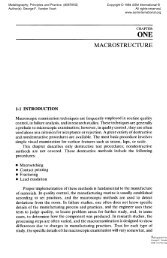Modeling and Simulation of Press and Sinter ... - ASM International
Modeling and Simulation of Press and Sinter ... - ASM International
Modeling and Simulation of Press and Sinter ... - ASM International
Create successful ePaper yourself
Turn your PDF publications into a flip-book with our unique Google optimized e-Paper software.
330 / <strong>Simulation</strong> <strong>of</strong> Powder Metallurgy Processes<br />
Fig. 10<br />
Comparison <strong>of</strong> explicit <strong>and</strong> implicit methods for compaction simulation in the WC-Co system. (a) Meshed<br />
geometry. (b) Left, half-axis experimental result; center, full-axis explicit method result; <strong>and</strong> right, implicit<br />
method result. Source: Ref 35<br />
direction <strong>and</strong> stepping size. The searching<br />
direction is decided by the direct differentiation<br />
or adjoint variable methods, <strong>and</strong> the stepping<br />
size is usually selected by polynomial curve fitting.<br />
Using the results <strong>of</strong> a finite-element simulation<br />
with a mesh system generated by the<br />
given design variables, design sensitivities are<br />
calculated by the algorithm <strong>of</strong> the searching<br />
direction. The searching direction is selected<br />
by the conjugate gradient method, <strong>and</strong> the<br />
proper stepping size is selected by the polynomial<br />
curve fitting, with the objective functions<br />
obtained by additional finite-element simulations.<br />
The design parameters are iteratively<br />
updated until the convergence criteria are satisfied.<br />
Figure 13 shows the procedure for optimizing<br />
the loading schedule to have uniform<br />
density distribution during die compaction for<br />
a hub part formed using a steel alloy powder<br />
(Ref 24). The design variables considered in<br />
this example were the loading schedules <strong>of</strong><br />
upper, inner lower, core rod, <strong>and</strong> die, <strong>and</strong> the<br />
objective function is the nonuniformity after<br />
die compaction. The goal was to minimize the<br />
nonuniformity. Figure 13(a) shows the compaction<br />
tool set <strong>and</strong> analysis domain. Figure 13(b)<br />
plots the objective function during optimization,<br />
<strong>and</strong> Fig. 13(c) plots the density distributions<br />
<strong>of</strong> the initial <strong>and</strong> optimum designs.<br />
<strong>Sinter</strong>ing Optimization<br />
Usually, a small grain size is desired to<br />
improve properties for a given sinter density.<br />
In this illustration, the design variable is the<br />
sintering cycle. To obtain maximum density<br />
<strong>and</strong> minimum grain size, the following objective<br />
function, F, is proposed (Ref 41):<br />
F ¼ a Dr<br />
r<br />
DG<br />
þ ð1aÞ G<br />
(Eq 5)<br />
where a is an adjustable parameter. Figure 14(a)<br />
shows an example for maximum density <strong>and</strong> minimum<br />
grain size for a 17-4 PH stainless steel powder.<br />
For example, the minimum grain size will be<br />
21.9 mm if the specified sintered density is 95% or<br />
theoretical. Figure 14(b) shows the corresponding<br />
Fig. 11 Final distorted shape by sintering under various gravitational environments for complicated test geometries. (a) T-shape. (b) Joint part. Source: Ref 40

















